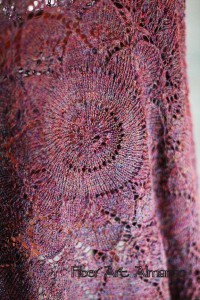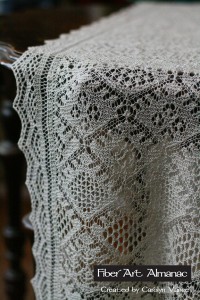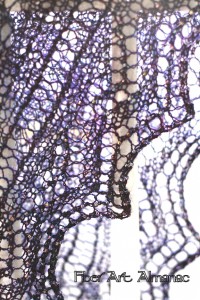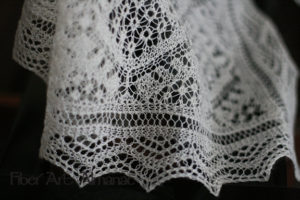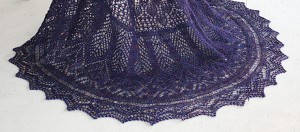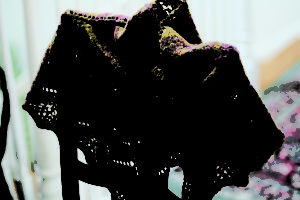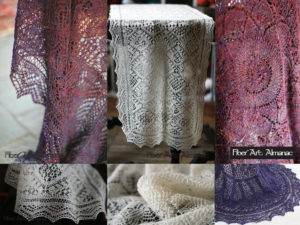
Today I have two examples of lovely lace pieces from two Minnesota knitters. They are Carolyn Vance from Vernon, Minnesota and Alyssa Krakowski from the Twin Cities. Each example of their knitting is unique not just in pattern and style but in construction.
Alyssa’s gorgeous shawl is knit in a circle from the center out. The edges are tipped with beads, but the marvel of her work is that she spun the fiber. It is also an example of lace knitting. I love the center medallion and how it flows out to the delicate edges. When she wears it, she just casually tosses the thing around her shoulders. I think I would have framed it and hung it on the wall of my living room! (Alyssa won a First Premium at the Minnesota State Fair with this shawl. THAT is a big deal. Yes, we still go nuts over the state fair here on the northern tundra, then).
Carolyn’s shawl is a beautiful example of knitted lace. It is a derivative of the Queen Susan shawl. It’s the outcome of commentary between members of the Heirloom Knitting Forum on Ravelry (the fiber world’s answer to social media). The Queen Susan lace pattern was designed by members of the forum based on a shawl in the Shetland Isles Museum. That collaborative effort from all parts of the globe is pretty amazing.
Okay, note that I mentioned lace knitting and then I mentioned knitted lace. When I sat down to talk with Carolyn Vance for the Almanac a while ago, she asked me if I knew the difference between the two. As I mentioned earlier, my knitting prowess has to do with thick woolly sweaters, so I was clueless.
To the casual eye, they both look like a marvel of knitted engineering, which they are indeed. But look closely at the strands of yarn between the yarnovers (holes). Some are twisted and some are straight. The twisted strands are the result of lace knitting. That’s also called single sided lace. I found this very detailed article on lace knitting in the archives of Vogue Knitting online. It’s written by Shirley Paden. Here’s how she defines lace knitting,
“With these stitch patterns, the lace pattern is worked on every other row with one purl row in between. The patterns are easier to follow, since there is always a “breather” row between lace rows and the lace construction always continues from the same starting point that is the beginning of each RSR.”
Okay, you probably guessed it. Knitted lace is considered double sided lace and that’s when you work the lace stitch, creating yarnovers (adding stitches) and decreasing stitches on both sides of the work. There are so many variations with this, and yes, purl stitches are a part of both knitted lace and lace knitting. Here’s Shirley’s definition on knitted lace,
“With these stitch patterns, the lace motifs are constructed on every row. Some of the more gossamer lace stitch patterns call for this technique. An easy way to determine which of the two techniques has been used on a lace piece is to look for the purl-stitch twists in the yarnovers. Most pattern stitches use one method or the other, but several combine the two techniques. The Frost Flowers pattern is an example of a lace structure in which one part of the pattern is worked in lace knitting and one part is worked in knitted lace.”
Sounds like the two techniques can be combined for even more complex patterning. I recommend Shirley’s written tutorial because she details the steps to create lace charts; she explains the ins and outs of shaping and goes into dishy detail about pattern structure. This information is excellent in its detail and the concepts are easily grasped through her articulate writing. Shirley also refers to Alternating Stitch Count and Single Row Lace as two additional methods of using lace stitch patterns in a piece. There are two parts to her discussion which are accessible here:
Here’s my first attempt at lace knitting. Thankfully the pattern was written and not charted.
Happy knitting!
–Jenny

